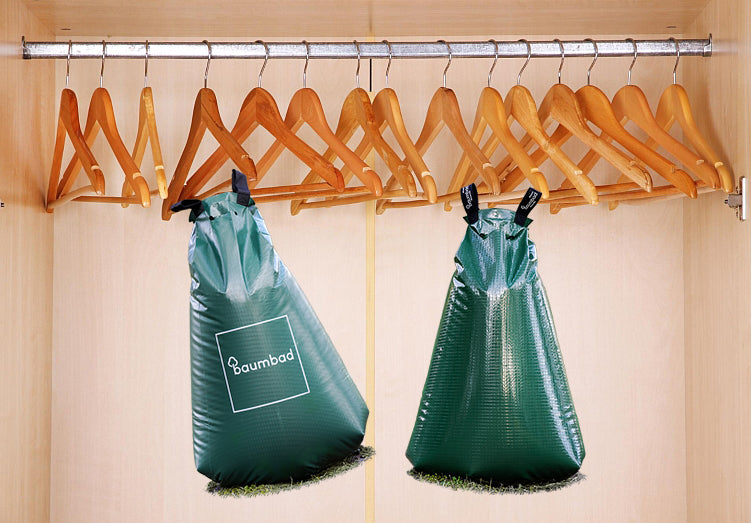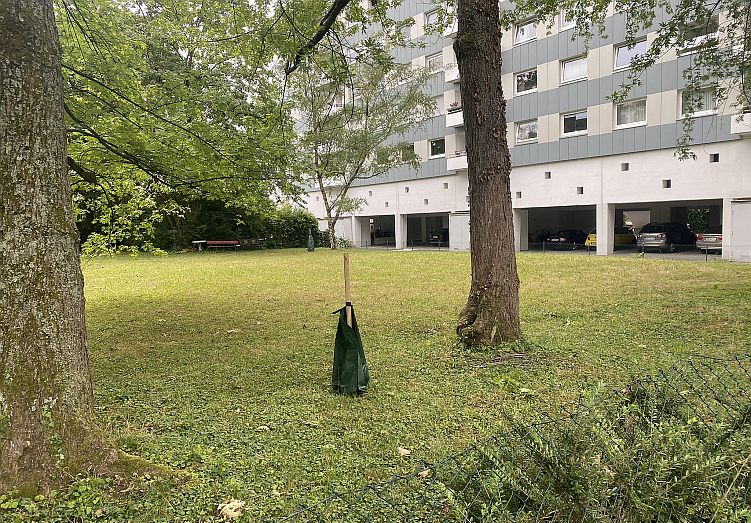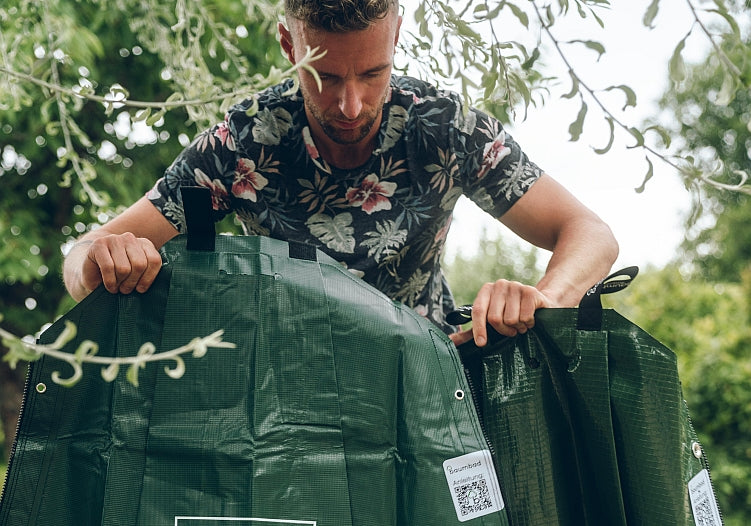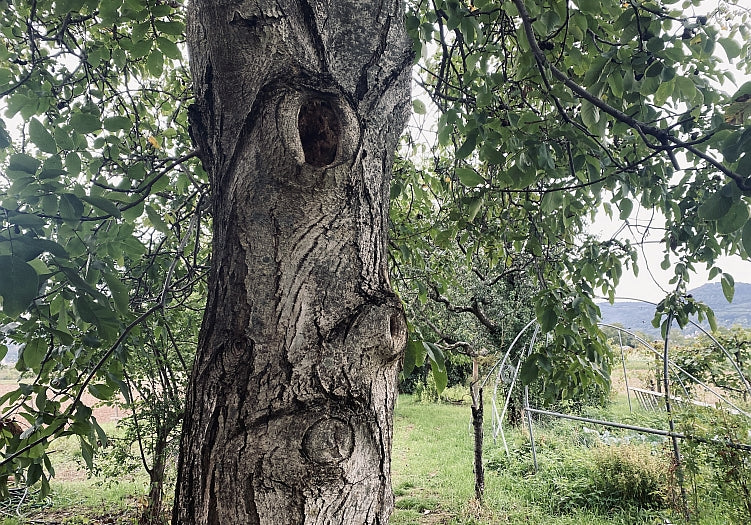Instructions for using a tree watering bag
Instruction manual for a 75-100 liter tree bag
Please follow the instructions carefully, then you will enjoy your tree bath for a long time!
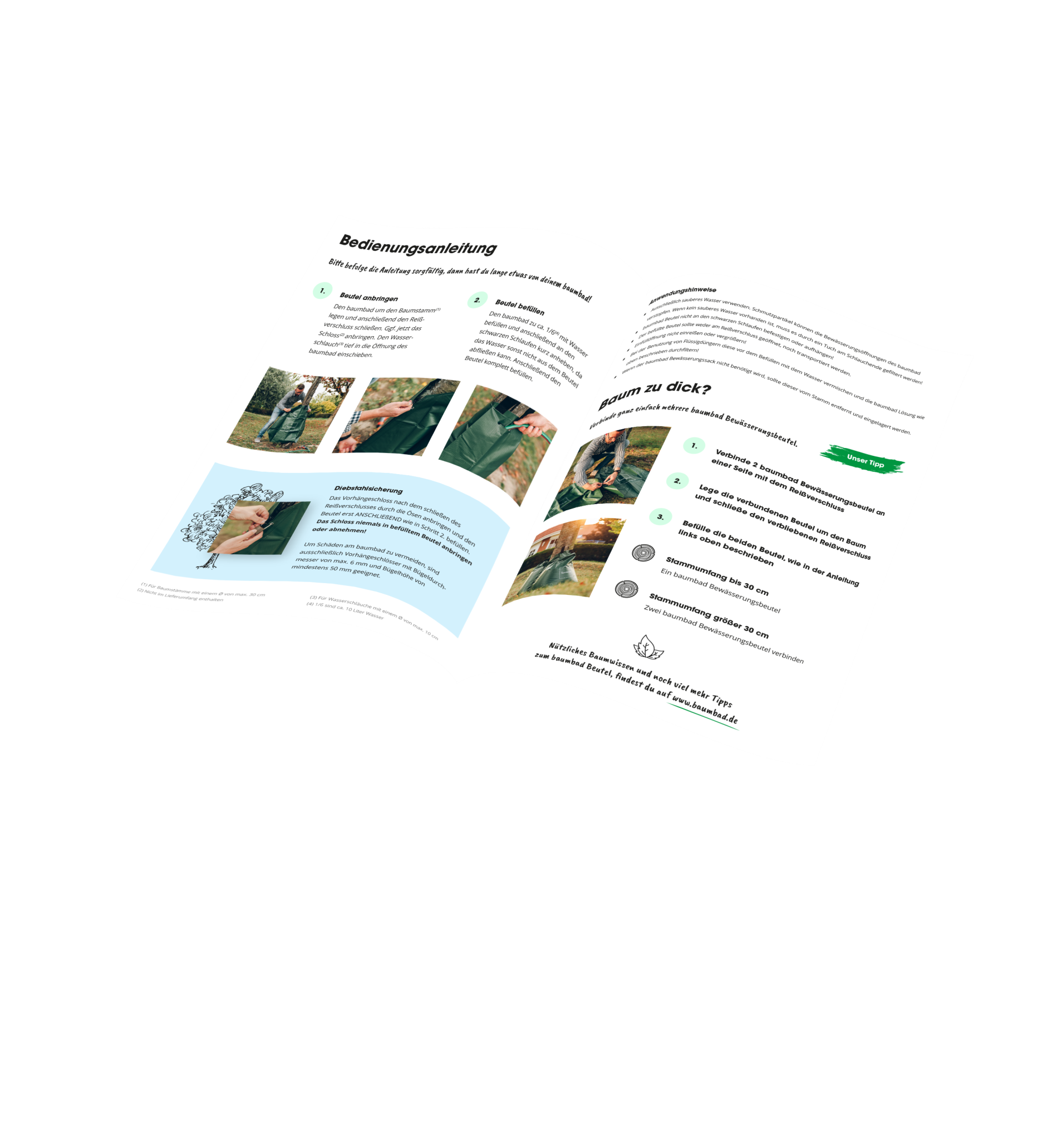
Video instructions with many examples and tips are on the “Questions and Answers” page
The instruction with videos is also in many languages In Stock
1st step
Mounting on the tree
Attach the bag and fill it
Place the tree bath around the tree trunk* and then close the zipper. If necessary, attach the lock now. Insert the water hose** deep into the opening of the tree bath.
Then fill the tree bath with approx. 5-10 liters of water and then shake it up slightly using the black loops***. This is important so that the drip holes do not become blocked and the water can drain out of the bag.
Then fill the bag completely. Alternatively, the drip holes can also be opened in the folds on the left and right with one hand movement****. (Video below)
* (for tree trunks with a circumference of max. 30 cm)
** (not included in the delivery)
*** (for water hoses up to 4 inches in circumference)
**** (do not lift)
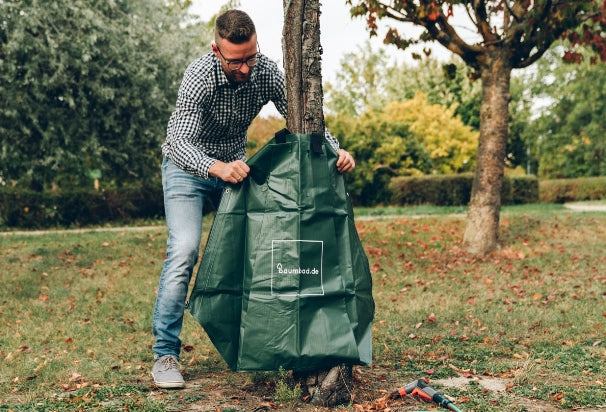
1) Place the bag around the trunk
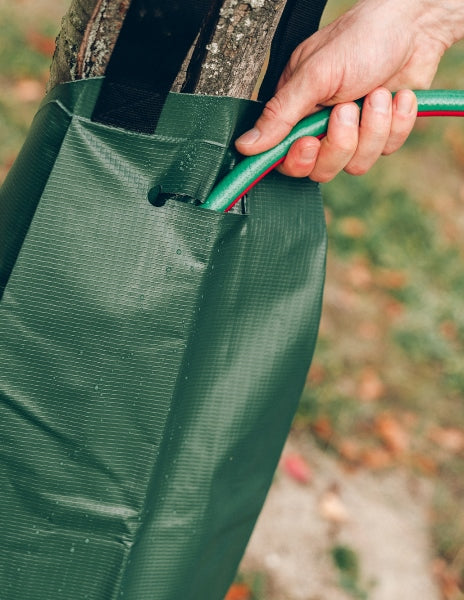
dann
3) Fill with water
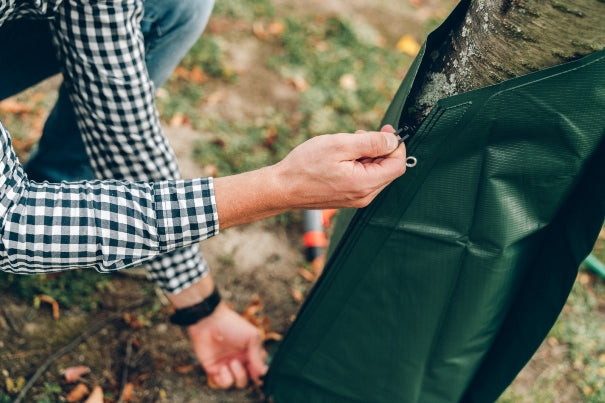
2) Close the zipper
Tips as a video: baumbad also has short videos for all installation steps
video Tutorial
Handle for constipation
Handle for constipation
The tree watering bags are constructed so that water drips out of two holes at the bottom folds. These holes are one on the left and one on the right. If these are not correctly positioned by shaking during filling, the water will drain more slowly than in 6 to 9 hours.
So please watch the video again on how to shake the bags correctly.
Solutions for slow emptying:
1) Check whether the material is slightly stuck together in these places and try to pick there.
2)It may be that the bags are in a hollow/cavity around the tree
stand? Then please check here too whether the material closes the holes in this position. The holes can then be exposed by lightly plucking. We'll show you how to do this in the following video.
Please take a look and see if this suggested solution helps you. Otherwise, please contact our customer support immediately or book a free appointment with a tree expert. We will help you and find a solution.
Shake up
Shake up
This is how things really get shaken up
Place bag around tree
Place bag around tree
Fill the bag
Fill the bag
Attach anti-theft protection
Attach anti-theft protection
How do tree bags work - application, installation, securing and...
How do tree bags work - use, set up, secure and fill
What is a tree watering bag? How do I fill it? What needs to be taken into account when using it? How can I secure it against theft? What is drip irrigation? What are the benefits of watering with a tree watering bag? In this video we answer all of these questions about the baumbad tree watering bag. We'll show you how easy watering is with an irrigation bag and what you should pay attention to when using it in order to get the best watering result and thus support your trees in the best possible way.
Attach anti-theft device
After closing the zipper, attach the padlock through the eyelets and then fill the bag. Never attach or remove the lock to a filled bag!
To avoid damage, please pay attention to the lock size!
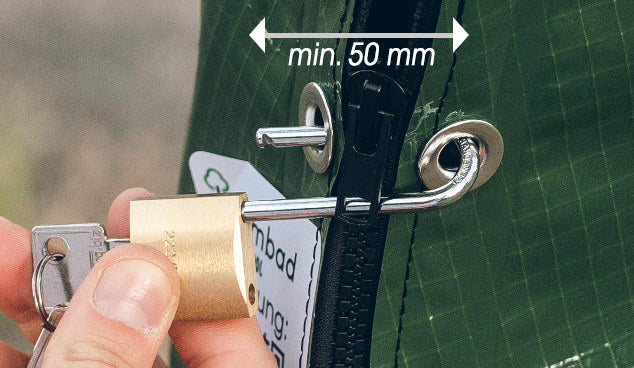
Lock size: shackle height of at least 50 mm and shackle diameter of max. 6 mm
Easily connect several watering bags with the zipper
Tree too thick?
Bags can be set up individually
Bags can be set up individually
There may not be enough tree bags to connect a thick tree in the combination. Branches and branches that are located where the irrigation bag is normally placed around the tree have a similar problem. In such a case, the bag can also be placed next to the tree to be watered. The best way to do this is with a wooden pole, bamboo pole or a metal rod. This must be inserted into the soil without damaging larger roots. The tree bag is very stable on its own and only requires a little support.
Connect bag - trunk circumference greater than 30 cm
Connect bag - trunk circumference greater than 30 cm
1) Connect two baumbad watering bags on one side with the zipper.
Trunk circumference greater than 60 cm means connecting 3 bags
Trunk circumference greater than 60 cm means connecting 3 bags
1) Connect three baumbad watering bags on one side with the zipper.
2) Place the connected bags around the tree and close the remaining zipper.
3) Fill the bags as described in the instructions.
Mature trees with a circumference of more than 90 cm
Mature trees with a circumference of more than 90 cm
Only with older trees that have a circumference of more than 90 cm will several irrigation bags be necessary. These can be connected to each other using the clever zipper solution. Branches and branches that are located where the irrigation bag is normally placed around the tree have a similar problem. In such a case, the bags can also be placed next to the tree to be watered. The best way to do this is with a wooden pole, bamboo pole or a metal rod. This must be inserted into the soil without damaging larger roots. The tree bag is very stable on its own and only requires a little support.
Quick help for your request
Application Notes:
Do not attach or hang on the black loops!
The loops are only intended for shaking the bag. When shaking, the bag may only be lifted slightly. Pulling up while leaving the bag from the floor is prohibited!
Use only clean water.
Dirt particles can clog the irrigation openings of the tree bath. If clean water is not available, it must be filtered through a cloth at the end of the hose! Each bag also has a dirt collection basin installed. To empty this, regularly empty the remaining water in the bag through the filling opening. To do this, hold the bag upside down.
The filled bag should neither be opened by the zipper nor transported.
A filled bag weighs between 75 kg and 100 kg. Such a weight cannot be supported by the PVC and PE material. The material would tear and the bag would be defective.
Do not tear or enlarge the filler opening!
If you plan to use your tree watering bags for many years, you should never do the following things:
• Clean the bags with sharp objects
• Do not remove the bags from the tree for a short moment for several months
• Never pour out the remaining water in the bag
• Use stale water with algae from ponds
• Crimp the bags at high temperature and pressure
• Leave the bags on the tree even during storms, hail, frost and snow
• Drill/prick additional holes in the bags independently
• Place bag on sharp objects
When using liquid fertilizers, mix them with the water before filling.
Depending on which fertilizer is used, it can attack the material. In addition to diluting with water, we also recommend using organic liquid fertilizer. This works well with a watering can. The mixed fertilizer can then be added to the water in the bag using the watering can via the filling opening.
Check the tree trunk regularly and let the tree breathe
Remove the bag from time to time in persistent humidity and tropical weather conditions to avoid the formation of mold or ant nests. The tree should be ventilated occasionally at the location of the bag.
Store when not in use.
To do this, remove the bag from the trunk, clean, dry and store in a dry place.
Check the tree trunk regularly and let the tree breathe
If the weather conditions are persistently humid or tropical, remove the bag from time to time to avoid the formation of mold or ant nests. The tree should be ventilated occasionally at the location of the bag.
Help water the trees
a few more tips & tricks
What is drip irrigation on trees?
What is drip irrigation on trees?
Drip irrigation refers to a watering method in which the water
very resource-saving over a long period of time for droplets
Droplets are released into the soil. This allows the water to be deep
Penetrate into the ground and particularly reach the roots of the tree
good, which means the tree can be optimally supplied with water.
go to Article: Drip irrigation in detail
How do you recognize drought stress in trees?
How do you recognize drought stress in trees?
Is growth delayed in the growing season, ie the shoots are
very short or the leaves are very small, then these are clear signs
for drought stress.
How do you know that a tree needs water?
How do you know that a tree needs water?
In spring and summer there are drooping and wilting leaves, leaf fall and
squashed growth (very short shoots) clear signs that a
Tree urgently needs water.
How much water does a tree need on average?
How much water does a tree need on average?
There is no blanket answer to this question
Answer. This depends on many factors, such as the type of tree and the size
of the tree, the location, the soil conditions, etc.
But there is a rule of thumb:
A medium-sized tree needs 150-200 liters per watering cycle.
Ie two fillings of one Baumbad watering bag or one filling of two connected watering bags.
How can you support urban trees in drought?
How can you support urban trees in drought?
Pour a large amount of water 1-2 times a week.
Recommendation: 150-200l = 2-3 fillings of a tree bath watering bag per watering.
About that
In addition, you can help city trees very well by protecting the upper ones
Loosen the soil layers to prevent the soil from compacting heavily
to break into cities. This often leads to the water
Watering or not being able to penetrate the soil at all when it rains
to reach the roots of the tree, but simply superficial
expires.
What is a tree watering bag?
What is a tree watering bag?
A tree watering bag is the ideal watering aid for trees.
The sack is placed around the trunk like a jacket, with a
Zippered and then filled with water. This saves money
You water, time, money and become a #tree saver.
Maybe you have already seen the tree bags in your city.
Why are these bags placed around the tree?
So we want to explain this to you briefly: "Climate change has...
the climate has changed continuously in recent years.
As a result, it has tended to become warmer in Europe, and
rainfall reduced. All in all, it is now proven
drier. As a result, many plants and trees are lost
suffer from lack of water. The green bags on the trees are
Watering bags used to support the tree.
They save both water resources and time when watering
saved. What benefits the environment, the tree and people."
Tree watering bags - numerous articles, blogs and guides
Here you will find reviews and ratings as well as helpful information on exactly how tree watering bags work and for whom they are suitable.
Store tree watering bags and watering rings over the winter
If you store your tree watering bags at the end of the watering season, you can extend their lifespan...
Why the use of tree watering bags is worthwhile
The number of dry periods and hot days has been increasing rapidly for several years. Especially young...
An overview of the baumbad range
baumbad now offers various products: tree bags made of PVC, tree bags made of PE and G...
Tree watering bags for Swiss customers
Baumbad is now internationally known and sells tree watering bags in almost all e...
Maintain high-quality tree bags and thereby extend their lifespan
The high-quality baumbad watering bags also need the right care so that they last a long...
Tree watering bags for young and older trees
Tree watering bags are an ideal way to water young trees. But how does it look...
We have more articles about tree watering bags for you
How do you use tree watering bags and where are they used? You can find all of this and more in our advanced articles on tree irrigation bags.
Use the left / right arrows to navigate through the slideshow, or swipe left or right if you're using a mobile device






























